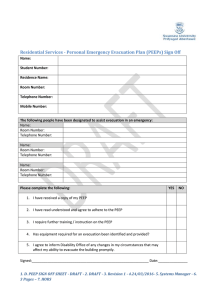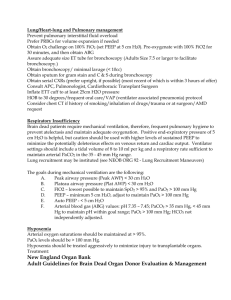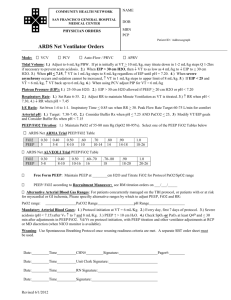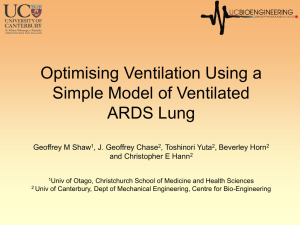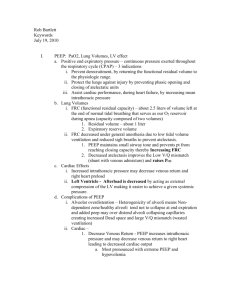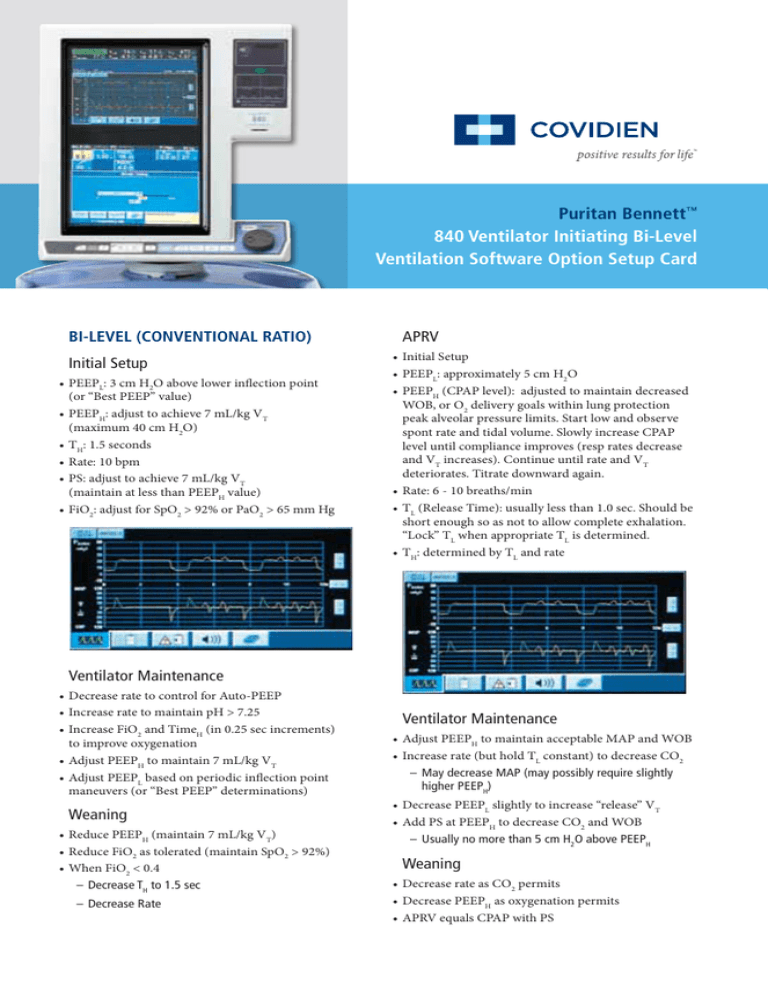
Puritan Bennett™
840 Ventilator Initiating Bi-Level
Ventilation Software Option Setup Card
Bi-Level (conventional ratio)
Initial Setup
•PEEPL: 3 cm H2O above lower inflection point (or “Best PEEP” value)
•PEEPH: adjust to achieve 7 mL/kg VT (maximum 40 cm H2O)
•TH: 1.5 seconds
•Rate: 10 bpm
•PS: adjust to achieve 7 mL/kg VT (maintain at less than PEEPH value)
•FiO2: adjust for SpO2 > 92% or PaO2 > 65 mm Hg
APRV
•Initial Setup
•PEEPL: approximately 5 cm H2O
•PEEPH (CPAP level): adjusted to maintain decreased
WOB, or O2 delivery goals within lung protection
peak alveolar pressure limits. Start low and observe
spont rate and tidal volume. Slowly increase CPAP
level until compliance improves (resp rates decrease
and VT increases). Continue until rate and VT
deteriorates. Titrate downward again.
•Rate: 6 - 10 breaths/min
•TL (Release Time): usually less than 1.0 sec. Should be
short enough so as not to allow complete exhalation.
“Lock” TL when appropriate TL is determined.
•TH: determined by TL and rate
Ventilator Maintenance
•Decrease rate to control for Auto-PEEP
•Increase rate to maintain pH > 7.25
•Increase FiO2 and TimeH (in 0.25 sec increments) to improve oxygenation
•Adjust PEEPH to maintain 7 mL/kg VT
•Adjust PEEPL based on periodic inflection point
maneuvers (or “Best PEEP” determinations)
Weaning
•Reduce PEEPH (maintain 7 mL/kg VT)
•Reduce FiO2 as tolerated (maintain SpO2 > 92%)
•When FiO2 < 0.4
–– Decrease TH to 1.5 sec
–– Decrease Rate
Ventilator Maintenance
•Adjust PEEPH to maintain acceptable MAP and WOB
•Increase rate (but hold TL constant) to decrease CO2
–– May decrease MAP (may possibly require slightly
higher PEEPH)
•Decrease PEEPL slightly to increase “release” VT
•Add PS at PEEPH to decrease CO2 and WOB
–– Usually no more than 5 cm H2O above PEEPH
Weaning
•Decrease rate as CO2 permits
•Decrease PEEPH as oxygenation permits
•APRV equals CPAP with PS
PCV Basics
Bi-Level Basics
•Pressure and inspiratory time are set by the operator.
•Volume and flow are variable according to patient needs.
•Patient can breathe spontaneously during the
inspiratory and expiratory phase of the PC mandatory
breath cycle.
•Active valve allows free breathing anytime during mandatory breath delivery.
•PC cannot count or measure spontaneous breaths taken during TI .
•PC cannot synchronize transition to PEEP with patient’s spontaneous exhalation.
PC Settings
Bi-Level Settings
•Mode = A/C or SIMV
•PI = Inspiratory pressure (above PEEP)
•TI = Inspiratory time (operator can choose to setTE or I:E ratio instead of TI)
•PEEP
•Frequency = Respiratory rate
•Rise Time %
•PS (in SIMV) = above PEEP and only during TE
Example:
•PC settings: Mode = SIMV, PI = 20, TI = 1.0 sec, PEEP = 5 cm H2O
•Freq = 15 bpm, PS = 20 cm H2O
Monitored data:
•FTOT = 30, Mand PPEAK = 25 cm H2O Spont PPEAK = 25, PEEP = 5 cm H2O
•I:E = varies
PCV
PI
• Pressure and inspiratory time are set by the operator.
•Volume and flow are variable according to patient needs.
•Patient can breathe spontaneously during the
inspiratory and expiratory phase of the PC mandatory
breath cycle.
•Active valve allows free breathing during any phase of breath delivery.
•Bi-Level mode counts and measures spontaneous
breaths taken during TI .
•Bi-Level mode synchronizes transition to PEEPL .
with patient’s spontaneous exhalation.
Bi-Level Mode
Equals
•Mode = Bi-Level
•PEEPH = High PEEP (same as PI in PC); sets actual PIP. NOT above PEEP
•PEEPL = Low PEEP (same as PEEP in PC), TH = Time at High PEEP* (same as TI in PC) *operator can choose to set TL (Time at Low PEEP) or
TH:TL ratio (same as I:E ratio in PC)
•Frequency = Respiratory rate, rise time %
•PS = above PEEP
Example:
•Bi-Level settings: Mode = Bi-Level, PEEPH = 20, TH = 1.0 sec, PEEPL = 5 cm H2O, Freq = 15, PS = 20 cm H2O
Monitored data:
•FTOT = 45, Mand PPEAK = 20 cm H2O, Spont PPEAK = 25 (5 cm H2O above PEEPH), PEEP = 5 cm H2O
•I:E = varies
PEEPH
PEEP
Equals
PEEPL
TI
Equals
TH
TE
Equals
TL
I:E Ratio
Equals
TH :TL Ratio
COVIDIEN, COVIDIEN with logo, Covidien logo and positive
results for life are U.S. and internationally registered trademarks
of Covidien AG. Other brands are trademarks of a Covidien company.
©2008, 2011 Covidien. All rights reserved.
11-VE-0268 VE10403
6135 Gunbarrel Avenue
Boulder, CO
80301
800-635-5267
www.covidien.com

